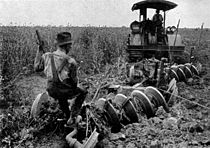
Back الزراعة في الولايات المتحدة Arabic Agricultura als Estats Units Catalan Landwirtschaft in den Vereinigten Staaten German Agrikulturo de Usono Esperanto Agricultura de Estados Unidos Spanish کشاورزی در ایالات متحده آمریکا Persian Agriculture aux États-Unis French חקלאות בארצות הברית HE Az Amerikai Egyesült Államok mezőgazdasága Hungarian Pertanian di Amerika Serikat ID

in north central Idaho
| This article is part of a series on the |
| Economy of the United States |
|---|
 |

shows a tractor plowing a crop field

Agriculture is a major industry in the United States, which is a net exporter of food.[1] As of the 2017 census of agriculture, there were 2.04 million farms, covering an area of 900 million acres (1,400,000 sq mi), an average of 441 acres (178 hectares) per farm.[2]
Agriculture in the United States is highly mechanized, with an average of only one farmer or farm laborer required per square kilometer of farmland for agricultural production.
Although agricultural activity occurs in every U.S. state, it is particularly concentrated in the Central Valley of California and in the Great Plains, a vast expanse of flat arable land in the center of the nation, in the region west of the Great Lakes and east of the Rocky Mountains. The eastern wetter half is a major corn and soybean-producing region known as the Corn Belt, and the western drier half is known as the Wheat Belt because of its high rate of wheat production.[3] The Central Valley of California produces fruits, vegetables, and nuts. The American South has historically been a large producer of cotton, tobacco, and rice, but it has declined in agricultural production over the past century. Florida leads the nation in citrus production and is the number two producer of oranges in the world behind only Brazil.
The U.S. has led developments in seed improvement, such as hybridization, and in expanding uses for crops from the work of George Washington Carver to bioplastics and biofuels. The mechanization of farming and intensive farming have been major themes in U.S. history, including John Deere's steel plow, Cyrus McCormick's mechanical reaper, Eli Whitney's cotton gin, and the widespread success of the Fordson tractor and the combine harvester. Modern agriculture in the U.S. ranges from hobby farms and small-scale producers to large commercial farms that cover thousands of acres of cropland or rangeland.
- ^ "Latest U.S. Agricultural Trade Data." Archived 2019-10-13 at the Wayback Machine USDA Economic Research Service. Ed. Stephen MacDonald. USDA, 6 Sept. 2018.
- ^ "2017 Census of Agriculture". farmlandinfo.org. 2019-04-11. Archived from the original on 2021-09-04. Retrieved 2021-09-04.
- ^ Hatfield, J., 2012: Agriculture in the Midwest. In: U.S. National Climate Assessment Midwest Technical Input Report Archived 2013-06-21 at the Wayback Machine. J. Winkler, J. Andresen, J. Hatfield, D. Bidwell, and D. Brown, coordinators. Available from the Great Lakes Integrated Sciences and Assessments (GLISA) Center